At the climate change conference in Scotland President Biden suggested to reduce the level of methane emissions 30% worldwide by 2030.
First, let us see where the sources of methane are:
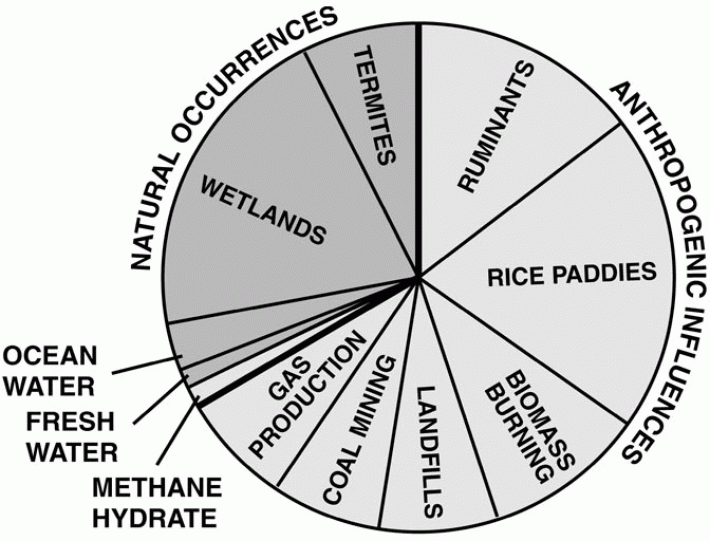
First, let us see that one third of greenhouse gases come from natural causes. To achieve 30% worldwide reduction by 2030 we must reduce anthropogenic methane by 42.8%
The first source is from ruminants, that is animals that chew their cud. There are over 150 species of ruminants like goats, sheep, elk, moose, bison, gnu, yak, reindeer, deer, all kinds of antelopes and so on, but for now let us concentrate on domesticated cattle, something we can control. There are about 1 billion cattle in the world, see picture

We can, at great expense collect the methane from the dairy cattle.

The rest are beef cattle and we have to get rid of half the beef cattle to get anywhere with the reduction in Methane. Unfortunately this messes up the environment. Check this out: https://lenbilen.com/2013/03/19/beef-whats-for-climate-is-cattle-herding-the-missing-link-in-restoring-the-balance-of-nature/ The rest of the ruminants: How many sheep do we have to do away with? How many goats? How many caribous? How many buffaloes? The best we can do on reducing the ruminant farts is about 4% of methane emissions, and that is at great expense of the balance of nature.
The next challenge is rice paddies. About 18% of all methane emissions emanate from rice paddies. Thanks to rising CO2 levels they are now more productive, India had a record harvest this year. China had too many floods to have a record harvest. Rice is the staple food for over half the world’s population, so it is best to tread carefully on forced reductions. But there is hope: There is a patented GMO modified rice that has less roots and thus produce less methane. See https://lenbilen.com/2015/07/29/growing-gmo-modified-rice-eliminates-methane-pollution-an-inconvenient-truth-for-green-heads-a-limerick/ Unfortunately GMO modified food is banned in much of the world, and I doubt these attitudes can be changed before 2030, so no reduction in rice paddy methane production will occur, instead methane production from rice paddies will increase slowly with increasing CO2 levels.
Next comes biomass burning and fermentation. There are many possible solutions.Over 200 years ago North Korea began to have methane stoves at their farms. They put compost in a closed cistern and led the gases from it into the stove and had heat to cook and heat for the house. It is labor intensive, but can be implemented many places. But seriously, field burning is very bad for the environment. The year-to-year spring variation in Arctic black carbon (BC) aerosol abundance is strongly correlated with biomass burning in the mid-latitudes. Moreover, current models underestimate the contribution of BC from biomass burning by a factor of three. Check the scientific paper on the issue: https://wattsupwiththat.com/2021/11/05/black-carbon-aerosols-heating-arctic-large-contribution-from-mid-latitude-biomass-burning/ While arctic snow is increasing in fall and winter it melts earlier in the spring thanks to black carbon changing the albedo of the snow. We should attempt to reduce biomass burning by at least half and reduce worldwide methane emission by 5%. The trick is to change the habit of subsistence farmers and western arsonists and the carelessness of people setting all the wildfires in the American west.
Landfills produce methane. The gases should be captured whenever economically defensible. It is possible to recover this methane in maybe one third of the landfills, reducing worldwide methane by 3%.
Mining and burning coal produce methane. While U.S has reduced its coal production by half in the last twenty years China is set to increase its coal consumption until at least 2030. India and much of the developing world are dependent on coal and will increase their consumption. See figure:
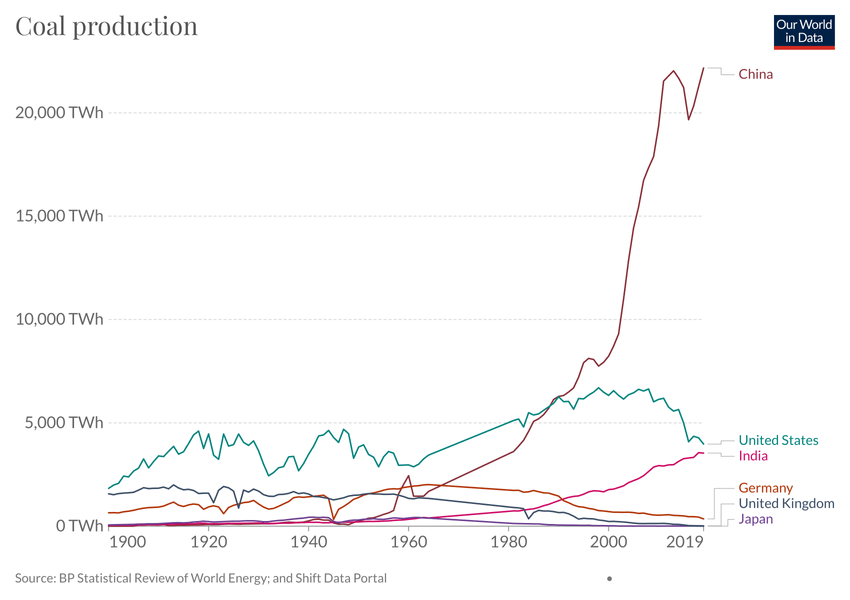
So no matter what u.s. will do, methane from coal will increase by probably 2% worldwide, and that assumes better mining, storing and burning practices.
Lastly methane leaked from gas production can be reduced by capping used oil and gas wells, recovering seepages, in short being environmentally vigilant. Properly managed, maybe half can be reduced world wide. This would reduce Methane leaks by 4%.
Total savings worldwide by 2030 using the best assumptions are: Ruminants: 4%, Rice Paddies: 0%, Biomass: 5%, Landfills: 3%, Coal: -2%, Gas production: 4%; for a total of 14%, less than half of what President Biden promised at the Glasgow Climate conference, or less than a third if he meant total methane production.
I am a conservationist. I care about the earth, and I want to leave the world a better place. I am not the least worried about methane, even though I am well aware that it is a 25 times stronger greenhouse gas than CO2.
Here is the deal. There are methane sinks in nature that nearly offset the methane sources:
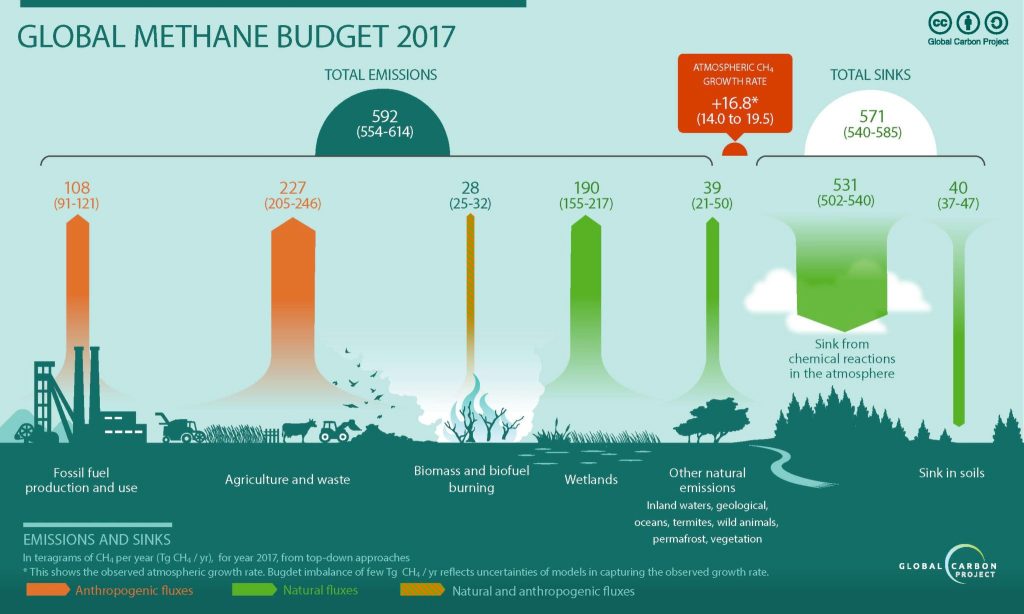
So we can see, the methane levels are in close balance. But the Methane levels are increasing:
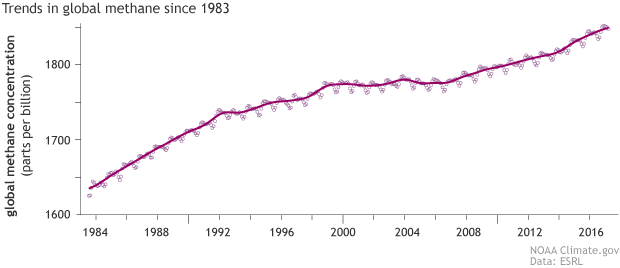
And the methane level in the atmosphere will continue to increase for a while. Yet, I am not worried. Here is the kicker. Methane is the don’t care gas when it comes to global warming, or climate change if you prefer that term. Methane absorbs in the same light bands as water vapor, and this is where climate models fail. If water vapor absorbs 99% of the energy at a certain wavelength and Methane absorbs another 50% of the energy at the same wavelength the sum is not 149%, but 99.5%. You cannot absorb more than all energy available at a certain wavelength. With this in mind we can look at the absorption spectra for water vapor and methane.
In the upper plot the red represents the incoming radiation absorbed by the ground, the white area represents energy absorbed in the atmosphere. The blue area represents the total energy escaping the earth, the white under the curves represent energy absorbed by the atmosphere causing the greenhouse effect, the three curves represent three temperatures, from left to right 310K, 260K and 210K.
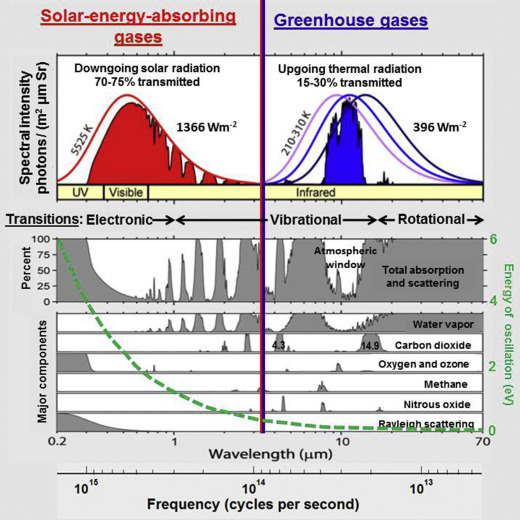
As we can see, water vapor absorbs nearly everywhere except in the region of visual light (thank God it is so, or we would be in eternal fog), and the so called atmospheric window. Methane absorbs in three wavelengths, the first two around 2 and 3 micrometers, but there water vapor absorbs nearly all energy in the atmosphere, and it is at a wavelength where solar influx is very low and earth radiance back to the sky is negligible, so they do not matter at all. The third wavelength, around 8 micrometers is where earth radiation is high, but even there water vapor is the dominant factor. Remember Methane concentration is less than 2 ppm and water vapor is counted in percent in the tropics, and even around the poles is the dominant absorbent. That is why I am saying, as a greenhouse gas, methane doesn’t matter.
Let us instead concentrate on things that do matter, deforestation, real pollution, and above all, clean and available water. Wind and solar uses up too many resources, and we will still depend on coal and natural gas to provide electricity when the sun doesn’t shine and the wind doesn’t blow, and our hydroelectric power storage is insufficient to accommodate much more of temporary energy sources. The only long time solution is to go nuclear, specifically LFTR until fusion energy is commercially viable.